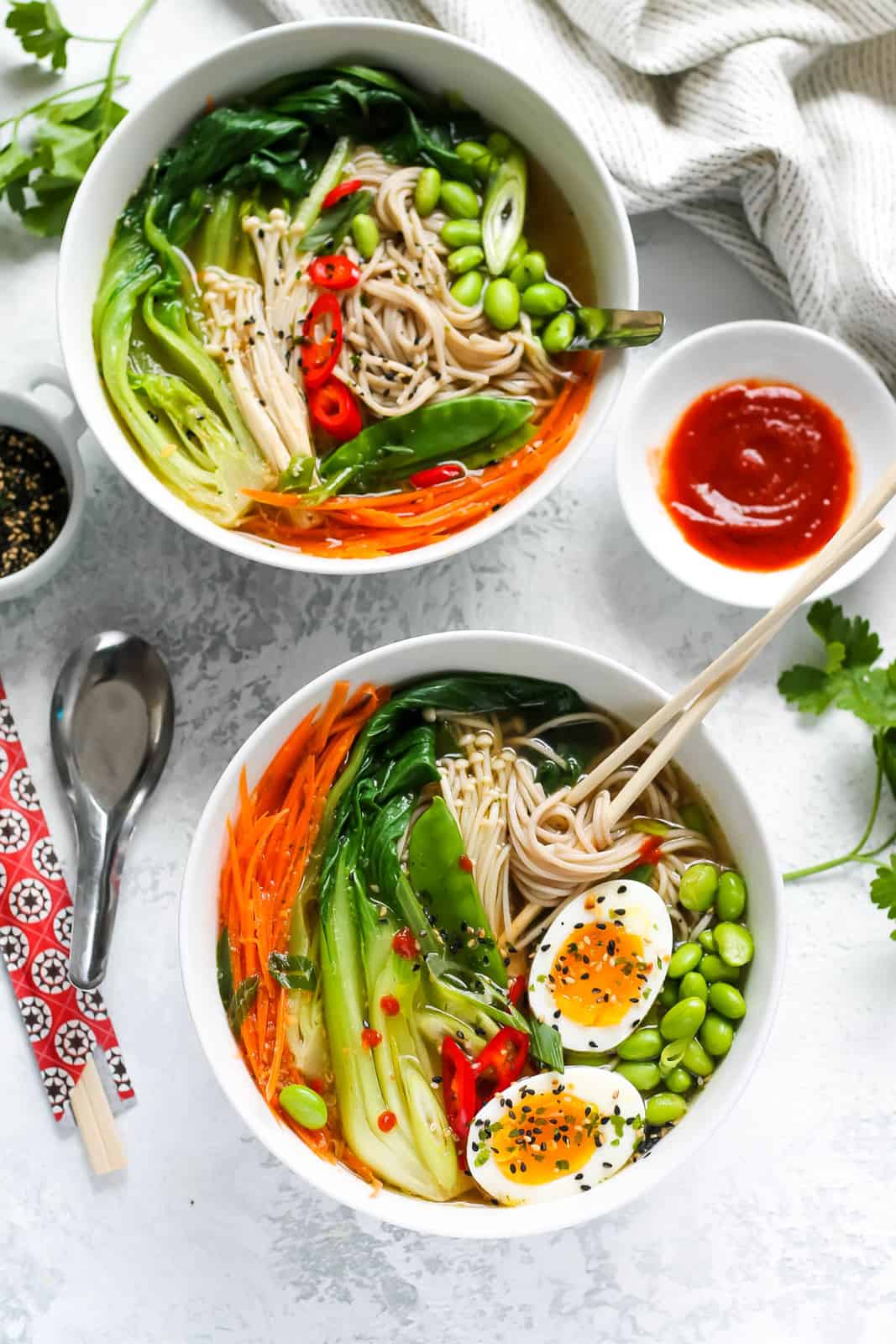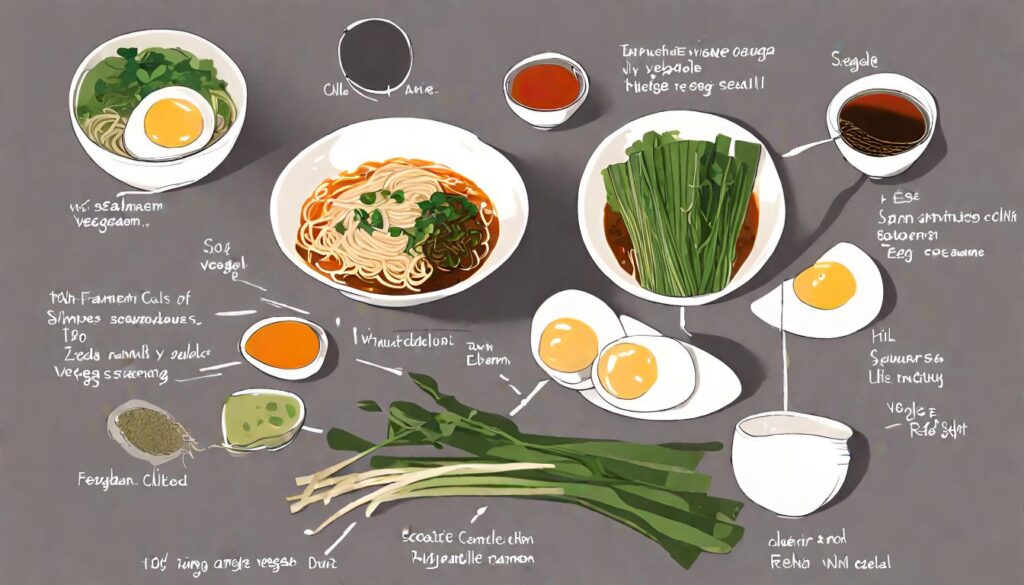Introduction to 10-Minute Vegetable Ramen Noodles
In the whirlwind of our daily lives, finding a balance between quick and healthy meals can often seem like a culinary conundrum. Enter the “10-Minute Vegetable Ramen Noodles” from Hey Nutrition Lady, a recipe that’s not just a lifesaver on hectic days but also a delightful journey into the heart of Asian cuisine. This dish stands out as a beacon of convenience and nutrition, offering a quick yet wholesome alternative to the usual fast-food options.
Are you craving a quick, healthy, and utterly delicious meal? Look no further than this 10-minute fancied-up veggie ramen! Perfect for those busy days, this veggie ramen recipe is not only easy to make but also packed with flavor and nutrition. Whether you’re a seasoned chef or a novice in the kitchen, this veggie ramen will become your go-to for a speedy and satisfying meal. Let’s dive into the world of quick ramen recipes and discover how to transform simple ingredients into a delightful veggie ramen dish.
The Essence of the Recipe
Simplicity and Adaptability of Vegetable Ramen
At the heart of the “10-Minute Vegetable Ramen” lies its remarkable simplicity and adaptability. This dish is a testament to the beauty of minimalism in cooking. With a base of aromatic vegetable broth, enriched with the earthy flavors of ginger and garlic, and the unique taste of miso paste, it forms a perfect foundation for a variety of additions. The soba noodles, with their distinctive texture, absorb these flavors, creating a harmonious blend in every bite.
But the true magic of this recipe is in its adaptability. Whether you’re a fan of crunchy bell peppers, sweet carrots, or leafy greens like spinach, this ramen graciously welcomes all. It’s a canvas for your culinary creativity, allowing you to experiment with different vegetable combinations each time you cook it. This flexibility not only adds variety to your meals but also helps in utilizing whatever ingredients you have at hand, reducing food waste.
Nutritional Benefits of Key Ingredients
Each ingredient in this recipe brings its own set of nutritional benefits. Bok choy, for instance, is not just a crunchy addition but a nutrient-dense vegetable. It’s packed with vitamins A, C, and K, and is known for its anti-inflammatory properties. The garlic and ginger, apart from adding depth to the flavor, are renowned for their immune-boosting qualities. And let’s not forget the miso paste, a fermented food that’s great for gut health.
The soba noodles, traditionally made from buckwheat, are a healthier alternative to regular pasta, being higher in protein and fiber. If you’re using instant ramen, opt for varieties with fewer additives for a healthier choice. This dish, in its entirety, is not just a treat for your taste buds but also a boon for your health.
Cooking Tips and Tricks
Mastering the Perfect Vegetable Ramen
Creating the perfect bowl of vegetable ramen is an art that can be easily mastered with a few tips and tricks. One key tip is to freeze your ginger. Grating frozen ginger is easier and it also retains its fresh zing. Another trick is to create a miso-paste slurry before adding it to the broth. This ensures even distribution of flavor and prevents clumping.
When it comes to cooking noodles, it’s important to not overcook them. Soba noodles, in particular, need to be al dente to maintain their texture. A quick rinse under cold water after boiling can stop the cooking process immediately, preserving their perfect texture.
Vegetable and Protein Variations
While this recipe is a celebration of vegetables, adding a protein source can make it a more filling meal. Tofu, tempeh, or even a soft-boiled egg can be great additions. For non-vegetarians, shredded chicken or thinly sliced beef can complement the flavors well. The beauty of this recipe lies in its versatility, making it suitable for various dietary preferences.
Serving and Presentation
How to Serve Your Ramen
Serving your ramen hot and fresh is crucial. The best way to serve it is in a deep bowl, allowing the broth to envelop the noodles and vegetables. Garnishing plays a significant role in elevating the visual appeal of the dish. A sprinkle of sesame seeds, a few drops of sesame oil, or a handful of fresh herbs can add color and aroma, enhancing the overall dining experience.
Adapting the Recipe for Different Occasions
This versatile recipe can be adapted for various occasions. For a quick weeknight dinner, keep it simple with basic ingredients. For a more elaborate weekend meal or when entertaining guests, you can add a variety of vegetables, proteins, and garnishes to make it more special. This dish is not just confined to dinner; it can be a comforting lunch or even a fulfilling brunch option.
FAQs Section
How Can I Make My Vegetable Ramen Gluten-Free?
To make your vegetable ramen gluten-free, opt for gluten-free noodles such as rice noodles or certain brands of soba noodles made purely from buckwheat. Also, ensure that the soy sauce and miso paste you use are labeled gluten-free.
What Are the Best Vegetables to Add to Veggie Ramen?
The best vegetables for ramen are those that offer a mix of textures and flavors. Leafy greens like bok choy, spinach, and kale, along with crunchy options like bell peppers, carrots, and snap peas, work well. Mushrooms add a nice umami flavor too.
Can I Prepare Vegetable Ramen in Advance?
Yes, you can prepare parts of the ramen in advance. Cook the noodles and prepare the broth ahead of time, but it’s best to add the vegetables and any proteins fresh when you’re ready to serve to maintain their texture and flavor.
How Can I Add More Protein to My Ramen?
To add more protein, consider tofu, tempeh, a soft-boiled egg, shredded chicken, or thinly sliced beef. These can be cooked separately and added to the ramen when serving.
Is Ramen Suitable for a Vegan Diet?
Yes, ramen can be easily adapted for a vegan diet. Use vegetable broth, omit any animal-based proteins, and ensure that your noodles, soy sauce, and miso paste are vegan-friendly.
Recipe Details

- Prep Time: 5 minutes
- Cook Time: 10 minutes
- Total Time: 15 minutes
- Servings: 1
- Calories: 523 kcal
Ingredients
- 1 teaspoon sesame oil
- 1 tablespoon fresh ginger, grated
- 1 clove garlic, minced
- 1 scallion, sliced
- 2 cups vegetable broth
- 1 tablespoon miso paste
- 2 oz soba noodles or one “cake” of instant ramen noodles
- ½-1 bunch bok choy, chopped into bite-sized pieces
- ½ medium carrot, shredded
- ½ cup shelled edamame
- ¼ cup cilantro, chopped
- ¼-1/2 a red chile, sliced
- 1 large soft-boiled egg (optional)
- Black sesame seeds for garnish
Directions
- Heat a medium-sized saucepan over medium-high heat. Add sesame oil, grated ginger, crushed garlic, and scallions. Sauté until vegetables are soft and just beginning to brown.
- Add the vegetable broth and scrape any bits from the bottom of the pot. Make a slurry with the miso paste and a few tablespoons of broth, then add it back into the broth.
- Add the noodles and cook for 3-4 minutes, stirring to break them up. When the noodles have mostly softened, add the vegetables.
- Let the ramen simmer for another couple of minutes, then transfer to a bowl.
- Garnish with sliced scallions, cilantro, and black sesame seeds. Season with soy sauce and/or Sriracha. Serve immediately.
Nutritional Information
- Calories: 523kcal
- Carbohydrates: 76g
- Protein: 31g
- Fat: 15g
- Saturated Fat: 3g
- Cholesterol: 164mg
- Sodium: 3329mg
- Potassium: 1733mg
- Fiber: 10g
- Sugar: 14g
- Vitamin A: 25489IU
- Vitamin C: 200mg
- Calcium: 544mg
- Iron: 8mg
Wrapping Up the Ultimate Vegetable Ramen Guide
In conclusion, this comprehensive guide to making “10-Minute Vegetable Ramen” is designed to not only walk you through a simple yet delicious recipe but also to deepen your understanding and appreciation of this versatile dish. From its nutritional benefits to its adaptability to various dietary needs, vegetable ramen stands out as a quick, healthy, and satisfying meal.
Whether you’re a seasoned cook or new to the kitchen, this guide aims to inspire you to explore the flavors and possibilities that ramen offers. Remember, cooking is an art, and with dishes like vegetable ramen, you have the freedom to experiment and make each bowl uniquely yours.


